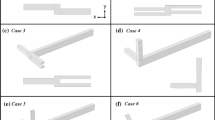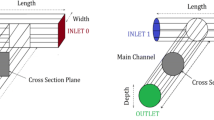Abstract
Short transport paths with high surface to volume ratios in microfluidic devices have the potential to increase the heat transfer significantly. However, because of the very low Reynolds numbers reached in microchannel flows, it is difficult to achieve effective thermal mixing. Microfluidic mixing requires fast mixing process of low diffusivity fluids. To obtain a rapid thermal mixing in passive micromixers, a porous block may be inserted to enhance the thermal performance. A 2D lattice Boltzmann thermal model is utilized here to investigate the thermal performance of a Y-micromixer with a porous block. Different parameters of porous block including its aspect ratio, its position, its porosity and its effective thermal conductivity are considered. The thermal mixing and cooling of two miscible fluids at 50 and 25 °C entering the micromixer are investigated in detail. The results show that the porous block significantly improves the thermal mixing of both streams. Increasing the porous block aspect ratio leads to better cooling, low entropy generation and high dimensionless entropy generation. It is also observed that thermal mixing and cooling performance increase by decreasing the effective thermal conductivity and porosity of the block, which causes a low entropy generation.





















Similar content being viewed by others

Abbreviations
- C:
-
Discrete lattice velocity
- Da:
-
Darcy number (= \( K/H^{2} \))
- f :
-
Distribution function for flow
- F :
-
Acceleration due to external force, (\( {\text{ms}}^{ - 2} \))
- g :
-
Distribution function for temperature
- H :
-
Characteristic height, (m)
- K :
-
Permeability, (\( {\text{m}}^{2} \))
- Nu :
-
Local Nusselt number, (\( = hx/k_{f} \)), (−)
- Pr :
-
Prandtl number, (\( = \upsilon /\theta \)), (−)
- Q :
-
Heat transfer to horizontal wall, (W)
- Re :
-
Reynolds number (= \( UH/\nu \)), (−)
- \( S^{'''}_{\text{gen}} \) :
-
Total volumetric entropy generation rate, (−)
- \( S^{'''}_{\text{P}} \) :
-
Volumetric entropy generation rate due to friction, (−)
- \( S^{'''}_{\text{T}} \) :
-
Volumetric entropy generation rate due to heat transfer, (−)
- S :
-
Entropy generation, (\( {\text{Wm}}^{ - 3} {\text{K}}^{ - 1} \))
- t :
-
Time, (s)
- T :
-
Temperature, (K)
- u :
-
Velocity component, (\( {\text{ms}}^{ - 1} \))
- x :
-
Dimension, (m)
- \( \varepsilon \) :
-
Porosity of porous media
- \( \mu \) :
-
Dynamic viscosity, (Pa.s)
- \( \rho \) :
-
Density, (kg/m³)
- \( \sigma \) :
-
Conductivity ratio (= \( K_{\text{f}} /K_{\text{s}} \))
- \( \upsilon \) :
-
Kinematic viscosity, (\( {\text{m}}^{2} {\text{s}}^{ - 1} \))
- \( \tau \) :
-
Relaxation time
- \( \omega \) :
-
Weighting factor
- eff:
-
Effective
- eq:
-
Equilibrium distribution function
- i, j:
-
Dimension directions
- k:
-
Lattice model direction
- gen:
-
Total generated
- LBM:
-
Lattice Boltzmann method
References
Myers KJ, Bakker A, Ryan D. Avoid agitation by selecting static mixers. Chem Eng Prog. 1997;93(6):28–38.
Wasewar KL, Sarathi JV. CFD modeling and simulation of jet mixed tanks. Eng Appl Comput Fluid Mech. 2008;2:155–71.
Fletcher PDI, Haswell SJ, Pombo-Villar E, Warrington BH, Watts P, Wong SYF. Micro reactors: principle and applications in organic synthesis. Tetrahedron. 2004;58(24):4735–57.
McFarland BL, Landy DG. Turbulent mixing of two streams in a 90° tee. AIChE J. 1980;76:351–8.
Zughbi HD, Khokhar ZH. Mixing in pipelines with side and opposed tees. Ind Eng Chem Res. 2003;42:5333–44.
Ogawa H, Igarashi M, Kimura N, Kamide H, Experimental study on fluid mixing phenomena in T-pipe junction with upstream elbow. In: Proceedings of the NURETH-11, Avignon, France, 2005
Hu L, Kazimi M. LES benchmark study of high cycle temperature fluctuations caused by thermal striping in a mixing tee. Int J Heat Fluid Flow. 2006;27:54–64.
Kuczaj AK, Komen EMJ, Loginov MS. Large eddy simulation study of turbulent mixing in a T-junction. Nucl Eng Des. 2010;240(9):2116–22.
Walker C, Simiano M, Zborayb R, Prassera HM. Investigations on mixing phenomena in single-phase flow in a T-junction geometry. Nucl Eng Des. 2009;239:116–26.
Wong SH, Ward MCL, Wharton CW. Micro T-mixer as a rapid mixing micromixer. Sens Actuators B. 2004;100:359–79.
Soleymani A, Yousefi H, Turunen I. Dimensionless number for identification of flow patterns inside a T-micromixer. Chem Eng Sci. 2008;63:5291–7.
Gobby D, Angeli P, Gavrilidis A. Mixing characteristics of T-type microfluidic mixers. J Micromech Microeng. 2001;11:126–32.
Chamkha AJ, Rashad AM, Armaghani T, Mansour MA. Effects of partial slip on entropy generation and MHD combined convection in a lid-driven porous enclosure saturated with a Cu–water nanofluid. J Therm Anal Calorim. 2018;132(2):1291–306.
Sheikholeslami M. Investigation of Coulomb force effects on ethylene glycol based nanofluid laminar flow in a porous enclosure. Appl Math Mech. 2018;39(9):1341–52.
Akbarzadeh M, Rashidi S, Karimi N, Omar N, First and second laws of thermodynamics analysis of nanofluid flow inside a heat exchanger duct with wavy walls and a porous insert. J Therm Anal Calorim, available online, 2018
Mashaei PR, Shahryari M, Madani S. Numerical hydrothermal analysis of water-Al2O3 nanofluid forced convection in a narrow annulus filled by porous medium considering variable properties. J Therm Anal Calorim. 2016;126(2):891–904.
Amirshekari M, Nassab SA, Javaran EJ, Numerical simulation of a three-layer porous heat exchanger considering lattice Boltzmann method simulation of fluid flow. J Therm Anal Calorim, available online, 2018
Oztop HF, Al-Salem K, Varol Y, Pop I, Firat M. Effects of inclination angle on natural convection in an inclined open porous cavity with non-isothermally heated wall. Int J Numer Meth Heat Fluid Flow. 2012;22(8):1053–72.
Siddiqui AA, Sheikholeslami M. TiO2-water nanofluid in a porous channel under the effects of an inclined magnetic field and variable thermal conductivity. Appl Math Mech. 2018;39(8):1201–16.
Baragh S, Shokouhmand H, Ajarostaghi SS, Nikian M. An experimental investigation on forced convection heat transfer of single-phase flow in a channel with different arrangements of porous media. Int J Therm Sci. 2018;134:370–9.
Baragh S, Shokouhmand H, Ajarostaghi SS. Experiments on mist flow and heat transfer in a tube fitted with porous media. Int J Therm Sci. 2019;137:388–98.
Shamsabadi H, Rashidi S, Esfahani JA, Entropy generation analysis for nanofluid flow inside a duct equipped with porous baffles. J Therm Anal Calorim, available online, 2018
Toghraie D, Mahmoudi M, Akbari OA, Pourfattah F, Heydari M, The effect of using water/CuO nanofluid and L-shaped porous ribs on the performance evaluation criterion of microchannels. J Therm Anal Calorim, available online, 2018
Bondarenko DS, Sheremet MA, Oztop HF, Abu-Hamdeh N, Mixed convection heat transfer of a nanofluid in a lid-driven enclosure with two adherent porous blocks. J Therm Anal Calorim, available online, 2018
Siavashi M, Joibary SM, Numerical performance analysis of a counter-flow double-pipe heat exchanger with using nanofluid and both sides partly filled with porous media. J Therm Anal Calorim, available online, 2018
Khan I, Khan WA, Effect of viscous dissipation on MHD Water-Cu and EG-Cu nanofluids flowing through a porous medium. J Therm Anal Calorim, available online, 2018
Chamkha AJ, Rashad AM, Armaghani T, Mansour MA. Effects of partial slip on entropy generation and MHD combined convection in a lid-driven porous enclosure saturated with a Cu–water nanofluid. J Therm Anal Calorim. 2018;132(2):1291–306.
Bejan A. Advanced engineering thermodynamics. 2nd ed. New-York: Wiley; 1997.
Bejan A. Fundamentals of exergy analysis, entropy-generation minimization, and the generation of flow architecture. Int J Energy Res. 2002;26:545–65.
Delavar MA, Farhadi M, Sedighi K. Effect of the heater location on heat transfer and entropy generation in the cavity using the lattice Boltzmann method. Heat Transf Res. 2009;40:521–36.
Delavar MA, Farhadi M, Sedighi K. Effect of discrete heater at the vertical wall of the cavity over the heat transfer and entropy generation using lattice Boltzmann method. Therm Sci. 2011;15(2):423–35.
Mohammad AA. Lattice Boltzmann method, fundamentals and engineering applications with computer codes. London: Springer; 2011.
Guo Z, Zhao TC. Lattice Boltzmann model for incompressible flows through porous media. Phys Rev E. 2002;66:036304.
Alazmi B, Vafai K. Analysis of fluid flow and heat transfer interfacial conditions between a porous medium and a fluid layer. Int J Heat Mass Transf. 2001;44:1735–49.
Kays WM, Crawford M. Solutions manual, convective heat and mass transfer. 3rd ed. New-York: McGraw-Hill; 1993. p. 9–11.
Acknowledgements
Sébastien Poncet acknowledges Natural Sciences and Engineering Research Council of Canada for its financial support through a discovery Grant (RGPIN-2015-06512).
Author information
Authors and Affiliations
Corresponding author
Additional information
Publisher's Note
Springer Nature remains neutral with regard to jurisdictional claims in published maps and institutional affiliations.
Rights and permissions
About this article
Cite this article
Ajarostaghi, S.S.M., Delavar, M.A. & Poncet, S. Thermal mixing, cooling and entropy generation in a micromixer with a porous zone by the lattice Boltzmann method. J Therm Anal Calorim 140, 1321–1339 (2020). https://doi.org/10.1007/s10973-019-08386-3
Received:
Accepted:
Published:
Issue Date:
DOI: https://doi.org/10.1007/s10973-019-08386-3



